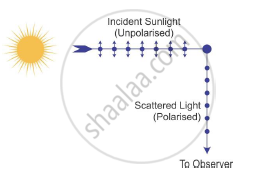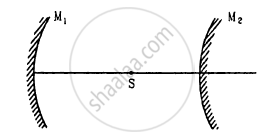Advertisements
Advertisements
प्रश्न
Show with the help of a diagram, how unpolarised light from Sun gets linearly polarised by scattering.
उत्तर
Polarisation of sunlight by scattering:

APPEARS IN
संबंधित प्रश्न
Why can’t we see clearly through fog?
Name the phenomenon responsible for it.
Why does the Sun look reddish at sunset or sunrise ?
The image formed by a concave mirror
A 1 cm object is placed perpendicular to the principal axis of a convex mirror of focal length 7.5 cm. Find its distance from the mirror if the image formed is 0.6 cm in size.
A converging mirror M1, a point source S and a diverging mirror M2 are arranged as shown in figure. The source is placed at a distance of 30 cm from M1. The focal length of each of the mirrors is 20 cm. Consider only the images formed by a maximum of two reflections. It is found that one image is formed on the source itself. (a) Find the distance between the two mirrors. (b) Find the location of the image formed by the single reflection from M2.

Answer the following question in detail.
State the conditions under which a rainbow can be seen.
Answer the following question in detail.
Is it possible to see primary and secondary rainbow simultaneously? Under what conditions?
A plano-convex lens is made of material having refractive index 1.5. The radius of curvature of curved surface is 40 cm. The focal length of the lens is ____________ cm.
| Case study: Mirage in deserts |
 |
|
To a distant observer, the light appears to be coming from somewhere below the ground. The observer naturally assumes that light is being reflected from the ground, say, by a pool of water near the tall object. Such inverted images of distant tall objects cause an optical illusion to the observer. This phenomenon is called mirage. This type of mirage is especially common in hot deserts. Based on the above facts, answer the following question : |
In an optical fibre, if n1 and n2 are the refractive indices of the core and cladding, then which among the following, would be a correct equation?
